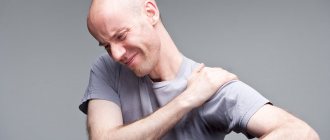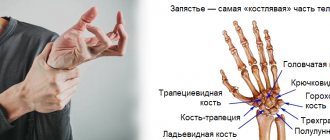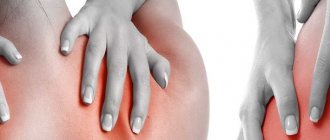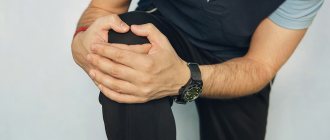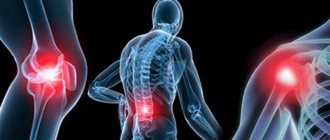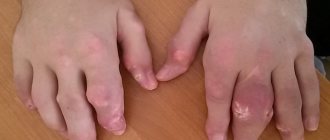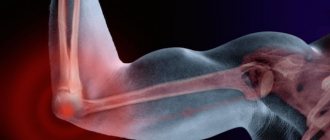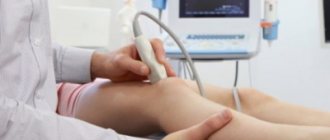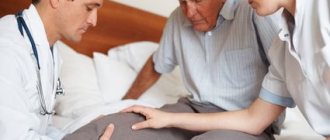In everyday life, when people use the word “elbow,” they mean the elbow joint, which connects the shoulder to the forearm. But not everyone knows that this is a complex joint, consisting of three joints (humeral-ulnar, humeroradial and proximal radioulnar) enclosed in one articular capsule. They are formed by three bones: the humerus, ulna and radius.
Due to its complex structure, the elbow is a movable joint that allows the arm to bend and extend. At this joint, you can rotate the forearm and rotate it outward and inward. However, due to a number of reasons, his mobility is limited. For example, a phenomenon may occur when the arm at the elbow does not fully extend. In this case we are talking about joint contracture.
The structure of the elbow joint
What does this term mean?
Contracture should not be understood as a situation where the elbow does not straighten exclusively. Sometimes the arm straightens, but there are problems moving in other directions.
Contracture is any limitation in the mobility of a joint. It is often accompanied by joint deformation, swelling and pain.
If we classify pathology by type of movement restriction, we can distinguish several types:
- flexion;
- extensor;
- pronation;
- supination, etc.
The first type is the most common. It manifests itself as difficulties when trying to straighten the arm or complete inability to make this movement.
Flexion contracture is diagnosed when the arm does not fully extend
There are four degrees of joint damage:
- In the first degree, the limitation is insignificant, since a person is able to extend the arm no less than 170°.
- If it extends in the range of 130°–170°, the second degree of contracture is diagnosed.
- At the next degree, extension is possible within 90°–130°.
- With the most severe degree of pathology, the extension angle does not exceed 90°.
Next, let's look at the possible causes of the disease.
Causes of contracture
There are many reasons causing this pathological condition. They can be divided into two large groups: injuries and diseases (congenital and acquired).
Injuries
Damage leading to pathology:
- Bruise is the most common injury. Usually it affects the olecranon, periarticular tissues, humeral condyle, and ulnar nerve.
- Partial or complete ligament ruptures.
- Various dislocations of the bones that form the joint.
Injuries also include fractures, which most often affect the internal joint of the ulna.
Fractured elbow as a result of falling on it
Signs of damage
The first sign of injury is acute, severe pain at the time of injury to the elbow. Then the injured area begins to swell and the color of the skin changes. Any attempts to move the injured limb are extremely painful. Pathological mobility cannot be ruled out. There may be numbness in the forearm, hand and fingers. When a fracture occurs, bone fragments may clearly protrude under the skin.
Consequences of fractures and bruises
After an injury, immobilization contracture may develop:
- Due to mechanical obstacles, if reposition was not carried out (comparison of bone fragments for their optimal fusion) or it was not done in the best way. In both cases, the bones do not heal properly, and mobility in the joint is limited.
- If scars have formed after ruptures of the ligaments or periarticular bursa.
- When a person, after a fracture, is forced to wear a plaster cast for a long time.
- If the brain has been damaged.
Less commonly, mobility suffers after puncture and cutting injuries to the periarticular muscles.
Diseases
The cause of impaired mobility may lie in congenital:
- Clubbing. There are two types of pathology (ulnar and radial). In the first case, the ulna bone is absent or underdeveloped, in the second - the radius. The latter type of pathology is most often observed.
- Dislocation of the radial head.
- Synostosis, which is a fusion of the ulna and radius bones.
Congenital bone abnormalities are accompanied by disturbances in the development of muscles, tendons and ligaments that serve the corresponding bones.
Two types of epicondylitis
Acquired diseases
Often the factors causing the development of styloiditis are:
- Excessive physical activity. One of the diseases of this nature is epicondylitis - “tennis elbow”. Due to constant overload of the forearm muscles, an inflammatory process begins in the places where the muscles attach to the bones.
- Long monotonous movements that a person is forced to perform in the course of one or another production activity. The tendons that attach to the styloid or olecranon process become inflamed.
- Bursitis or inflammation of the joint capsule, which negatively affects the range of motion in the joint.
- Various forms of arthritis. With this disease, which can be caused by many reasons, almost all joint structures (synovium, capsule, cartilage and others) suffer from inflammation.
Acquired pathologies also include arthrosis, a chronic disease leading to degenerative changes in the joint.
Diseases that cause elbow pain and their treatment
Lateral (external) epicondylitis
This is an inflammatory disease of the tendons of the forearm muscles.
(if the table is not completely visible, scroll to the right)
| Causes | Frequent microtraumas of ligaments and tendons, daily increased load on the elbow joint. |
| Characteristic symptoms | Increased pain during extension after carrying or lifting heavy objects and after prolonged monotonous movements. |
| Treatment | Ensuring joint immobility, corticosteroids, physiotherapy, therapeutic exercises. |
Medial (internal) epicondylitis
This is an inflammatory lesion of the internal tendons of the muscles connected to the medial epicondyle of the elbow joint.
(if the table is not completely visible, scroll to the right)
| Causes | Frequent injuries, professional sports, hard monotonous work. |
| Symptoms | Sharp pain when bending, which decreases when straightening the arm. Painful sensations “give” (radiate) to the hand and forearm area. |
| Treatment | The same as for lateral epicondylitis. |
Bursitis
Bursitis is an inflammation of the joint capsule accompanied by infection.
(if the table is not completely visible, scroll to the right)
| Causes | Trauma due to arthritis or gout. |
| Symptoms | Constant aching discomfort of a dull nature. Palpation or an attempt to straighten the joint is reflected by severe sharp pain. |
| Treatment | Ensuring complete rest for the joint, antibiotics, anti-inflammatory drugs. |
Arthritis
Arthritis is inflammation of joint tissues. Its main types are: reactive, post-traumatic and systemic (for example, rheumatoid - when the disease affects the entire body).
(if the table is not completely visible, scroll to the right)
| Causes | Occurs after severe forms of ARVI, rubella, bacterial infections or against the background of systemic connective tissue diseases. |
| Symptoms | Swelling and redness of the joint area. Severe sharp pain when bending and straightening the arm at the elbow. Dull aching pain in the elbow joint at rest. |
| Treatment | Physiotherapy, painkillers, non-steroidal anti-inflammatory drugs (NSAIDs). |
Arthrosis
Arthrosis is damage (destruction) of cartilage due to wear and tear.
(if the table is not completely visible, scroll to the right)
| Causes | Long-term constant stress on the joint due to injury, arthritis or due to hormonal imbalance. |
| Symptoms | Limitation of motor function of the joint, specific crunching and aching pain, intensifying with extension and rotation of the arm. |
| Treatment | Manual therapy, chondroprotectors, physiotherapy, massage, hyaluronic acid injections. |
Osteochondrosis of the cervical spine
Osteochondrosis is the destruction of intervertebral discs. Pain in this pathology is of a reflected nature (i.e., the nerves responsible for pain in the elbow and arm are pinched, leaving them at the level of the spinal column - without damaging the joint itself - but the person feels discomfort precisely in the elbow). Often such pain is combined with numbness and pain in the neck, under the shoulder blade.
Click on photo to enlarge
(if the table is not completely visible, scroll to the right)
| Causes | Sedentary lifestyle, unhealthy diet. |
| Symptoms | Constant dull aching pain in the elbow, numbness, piercing sharp pain when bending and straightening. |
| Treatment | Chondroprotectors, NSAIDs, therapeutic exercises. |
Diagnostics
If it is difficult or impossible to straighten your arm at the elbow, you should not treat with folk remedies at home. You can find a great variety of similar remedies and recipes on the Internet. However, not all of them are correct from a medical point of view. In addition, motor abnormalities in the elbow occur as a result of various factors. Therefore, each individual case requires its own approach to treatment.
A specialist must decide how to treat. Which doctors should I contact? A traumatologist, orthopedist, neurologist and rheumatologist will make the correct diagnosis and prescribe adequate treatment:
- Diagnosis begins with listening to the patient's complaints, examining the sore elbow and examining it with the fingers. The doctor finds out whether the person has suffered injuries or illnesses, how long it takes for the pathology to develop, what sensations it is accompanied by, etc.
- At the next stage, the patient is sent for general and biochemical blood tests. A general analysis of the level of leukocytes in the blood and the erythrocyte sedimentation rate allows us to determine the strength of the inflammatory process in the body. The second type of analysis provides information about the presence of arthritis, damage to internal organs, and metabolic disorders.
- If necessary, synovial fluid from the joint cavity can be taken for analysis.
- An x-ray of the damaged joint is required to identify its anomalies.
X-ray of the elbow joint
To clarify the diagnosis, instrumental examination methods such as magnetic resonance imaging, computed tomography and ultrasound can be used.
Therapy
Treatment methods depend on the diagnosis:
- If necessary, elbow immobilization can be performed.
- In case of severe pain, a joint block is performed.
- Non-steroidal anti-inflammatory drugs are prescribed to relieve inflammation and relieve pain.
- Physiotherapeutic procedures are actively used (massage, various methods of traction, mechanotherapy, etc.).
- Surgical intervention is practiced when bone fragments have not healed properly or rough scars have formed that impede free movement. The nature of the operation is determined by the type and severity of the pathology. In especially severe cases, joint replacement is practiced.
During the recovery period, regular exercise of the joint will be useful. A set of exercises will be selected by a specialist in physical therapy.
Even if you have minor problems with elbow movements, you should not hesitate to visit a medical facility. Delay can result in joint degradation with a concomitant deterioration in quality of life.
More information about the anatomy of the elbow can be obtained from the video:
You can learn about exercises for elbow epicondylitis by watching the following video:
Similar:
- Disability due to gout: the essence of the disease and the registration process
- Methods of treatment for a fracture of the elbow joint, causes and symptoms of injury, rules of rehabilitation
- Diuretics for gout: is it possible or not?
- How does aseptic necrosis of the talus manifest itself, and why is it dangerous?
- When is an ultrasound of the elbow joint prescribed: contraindications and preparation
- How dangerous will synovitis of the elbow joint be if you do not consult a doctor in time?
- Review of the most common elbow diseases, their symptoms and treatment
Types of pain in the elbow during flexion and extension
Pain syndrome, depending on the disease that caused it, has its own characteristics. When examining a patient, the doctor always pays attention not only to what movement causes discomfort, but also what its nature is:
(if the table is not completely visible, scroll to the right)
| Type of pain | Reasons and characteristics |
| Reflected | It occurs against the background of pathologies in other organs or systems of the body - for example, with osteochondrosis of the cervical spine. Pain aching; sensation as if the source were concentrated in the elbow. When you try to bend or straighten your arm, you experience a nagging pain with tingling and numbness. |
| Projected | Occurs as a result of spinal injury or as a result of intervertebral hernia due to compression of the nerve roots of the spinal cord. Has a pulling character when bending the elbow. |
| Neuropathic | It occurs due to compression of the nerve roots or inflammation of the nerve fibers against the background of deforming arthrosis or injury. Characteristic features: sharpness and sharpness when bending, burning sensation when straightening the elbow. |
| Acute | Occurs with injuries, bursitis and reactive arthritis. Extending or bending the elbow causes severe, sharp pain. As a result, movements are limited. |
| Burning | Accompanies inflammatory diseases or compression of nerve endings. Extension of the arm is accompanied by a strong burning sensation. |
| Dull and aching | This is a symptom of chronic diseases of the elbow joint (initial stages of arthrosis, chronic elbow injuries, chronic bursitis). When bending and straightening, the pain increases, which is accompanied by tingling. |
